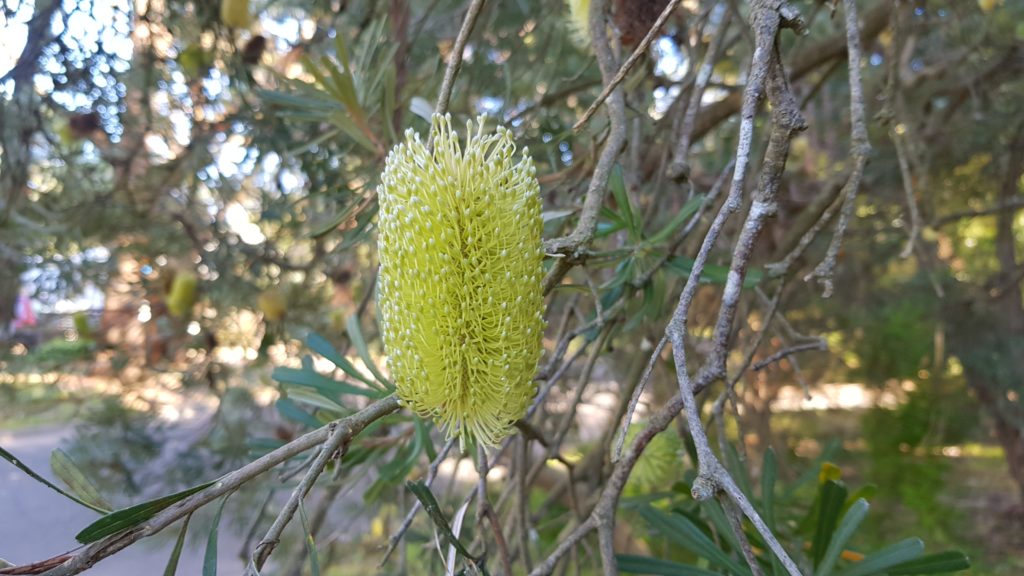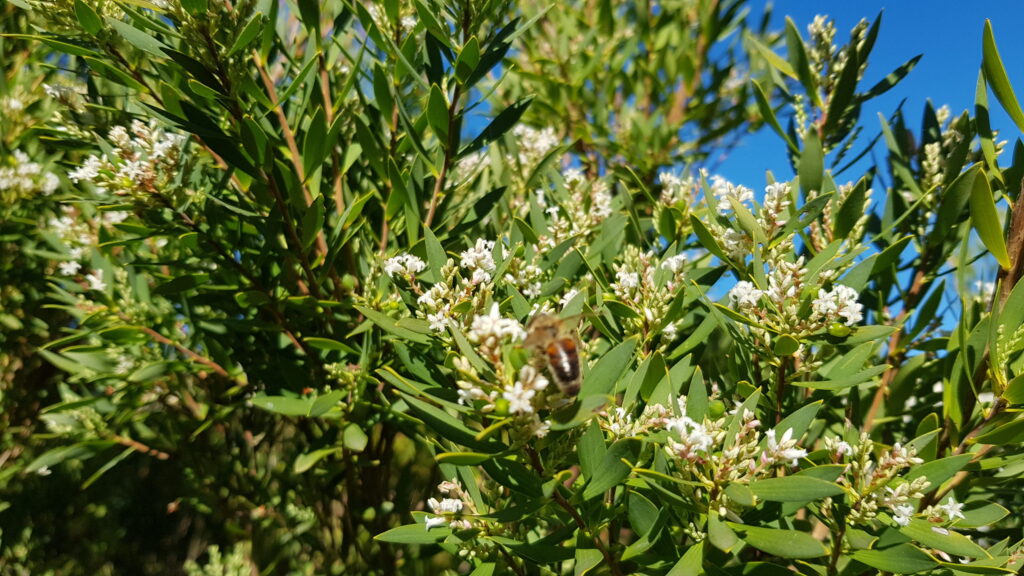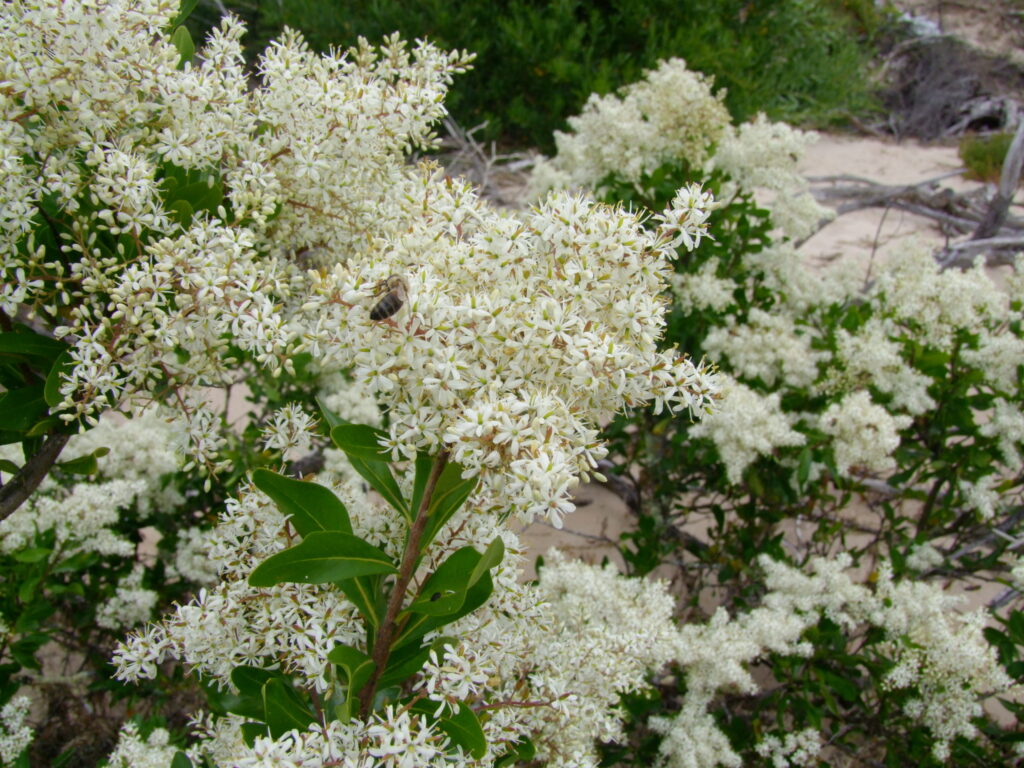“Bee populations are declining drastically around the world, threatening food production and wildlife. One in every three bites of food eaten worldwide depends on pollinators, especially bees, for a successful harvest. We are working to increase awareness, and provide bee-friendly native plants, to address this threat.”
Declining Bee Populations Pose a Threat to Global Agriculture

Indigenous native plants – Leucopogon parviflorus – Coast Beard-heath
Including indigenous species in new build home gardens such as the one shown in the image above, helps to create foraging options for bees and other pollinators.
It is important to think about the flowering cycles of plant species. A continual floral sequence can be achieved by mixing the indigenous plant species throughout your spaces and places.
For those of us with larger plots, think about your revegetation zones to include foodbase flora for pollinators (bees, insects, butterflies, birds etc) that may be able to support an apiary site.
Bee food suited as garden species
- Acacia dealbata – Silver Wattle
- Acacia longifolia ssp sophorae – Coast Wattle
- Acacia mearnsii – Black Wattle
- Acacia melanoxylon – Blackwood
- Acacia myrtifolia – Myrtle Wattle
- Acacia paradoxa – Hedge Wattle
- Acacia stricta – Hop Wattle
- Acacia suaveolens – Sweet Wattle
- Acacia verticillata – Prickly Moses
- Banksia integrifolia – Coast Banksia
- Banksia marginata – Silver Banksia
- Bossiaea cinerea – Showy Bossiaea
- Bursaria spinosa – Sweet Bursaria
- Cassinia aculeata – Common Cassinia
- Chrysocephalum apiculatum – Common Everlasting
- Clematis aristata – Old Man’s Beard
- Clematis microphylla – Small-leafed Clematis
- Coronidium scorpioides – Button Everlasting
- Correa alba – White Correa
- Eucalyptus kitsoniana – Gippsland Bog Gum
- Eucalyptus obliqua – Messmate
- Eucalyptus ovata – Swamp Gum
- Eucalyptus pauciflora – Snow Gum
- Eucalyptus radiata – Narrow-leafed Peppermint
- Eucalyptus viminalis ssp. pryoriana – Coast Manna
- Hakea nodosa – Yellow Hakea
- Hakea ulicina – Furze Hakea
- Indigofera australis – Austral Indigo
- Kennedia prostrata – Running Postman
- Leptospermum continentale – Prickly Teatree
- Leptospermum lanigerum – Woolly Teatree
- Leptospermum myrsinoides – Heath Teatree
- Leucophyta brownii – Cushion Bush
- Leucopogon parviflorus – Coast Beard-heath
- Melaleuca ericifolia – Swamp Paperbark
- Melaleuca squarrosa – Scented Paperbark
- Microseris sp. – Yam Daisy, Murnong
- Myoporum insulare – Boobialla
- Olearia axillaris – Coast Daisy-bush
- Olearia glutinosa – Sticky Daisy-bush
- Olearia lirata – Snowy Daisy-bush
- Olearia phlogopappa – Dusty Daisy-bush
- Olearia ramulosa – Twiggy Daisy-bush
- Ozothamnus ferrugineus – Tree Everlasting
- Pultenaea daphnoides – Large-leafed Bush-pea
- Senecio pinnatifolius – Variable Groundsel
- Variable Groundsel – Golden Spray
NOTE: You may see the indigenous species Leptospermum laevigatum (Coast Teatree) around our coast as this is often the species used in revegetation projects. With the significant erosion that is occurring along our coast, replenishing indigenous vegetation is critical to maintaining the biodiversity in the region and for sustaining wildlife, insects, birds etc as well as being a significant contributor to dune stabilization.

Plants growing in native bush, and those that can be seen at revegetation sites, such as Banksia integrifolia (Coast Banksia), Leocopogon parviflorus (Coast Beard-heath), Leptospermum laevigatum (Coast Teatree) and Bursaria spinosa (Sweet Bursaria), have dense flower heads. and are suitable for local gardens.
These plants will attract and support a wide range of native pollinators that will be ‘buzzing’ with activity when the flowers bloom. The whole tree or shrub will seem ‘alive’. Other species plants have flowers that ‘stand alone’ more and if you look carefully at the bees in action you can enjoy their antics and flight paths as they go from one flower to another flower.


Visit the WSBN orders page if you have a special spot for these beautiful shrubs/small trees in your garden. They are hardy, will tolerate sandy soil and will reward you with visitors that don’t need a cuppa!
Some resources about Bees:
- Gippsland Apiarist Assoc. – Based in Gippsland and services all of the Gippsland region
- The South Gippsland Beekeepers – Based in Leongatha
- Bee Friendly – A planting guide for European honeybees and Australian native pollinators
- Aussie Bee Guide to Bee Hotels
